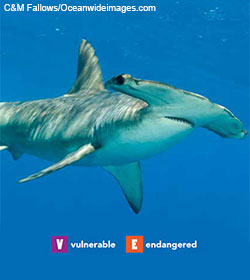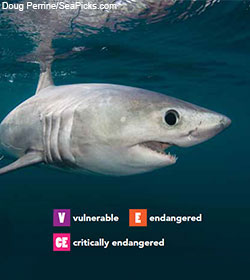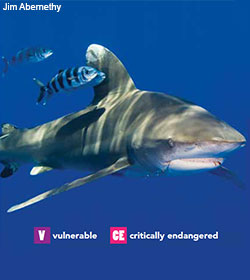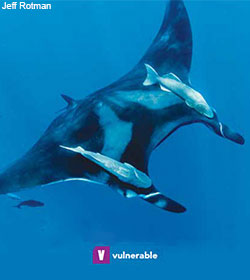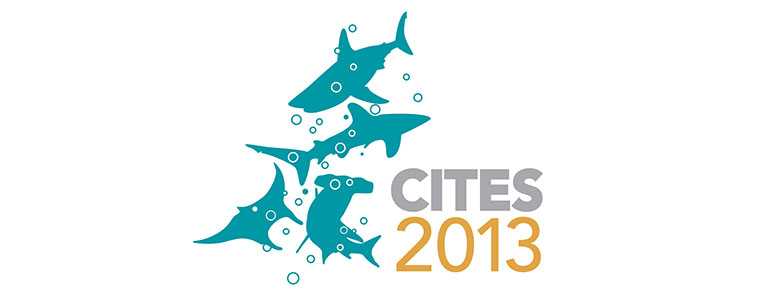CITES 2013: Year of the Shark, Media Guide
Additional Resources:
- UN Advisory Panel Recommends Support for CITES Shark Proposals
- Considering Shark Biology in Management
- Manta Ray Gill Plate ID Guide
- Shark Fin ID Guide
- New Appendix III Shark Listsings
Media Guide to the Convention on International Trade in Endangered Species of Wild Fauna and Flora (CITES)
The 16th meeting of the Conference of the Parties (CoP) will be held from March 3–14, 2013, in Bangkok, Thailand. CITES is widely recognized as one of the most effective and best-enforced international conservation agreements. It offers protection to more than 30,000 species around the globe and has been instrumental in preventing the extinction of numerous plants and animals.
The international trade of wild animals and plants, including fish and other marine life, is a multibillion-dollar business.
Overexploitation for international trade, in combination with habitat loss, habitat degradation, climate change, and other pressures, can threaten populations with significant depletion or, worst-case, extinction.
It is crucial that any international trade in plants, animals, and their products be managed in a sustainable and legal way. The Convention was constructed for this purpose.
CITES, an international treaty among 177 governments, entered into force in 1975.
CITES Meetings: Conference of the Parties
The 177 countries that are members of CITES are also known as “Parties.” They join voluntarily and are legally bound to implement the convention once they have become a member.
What Parties agree to do under CITES is not a substitute for their domestic laws and enforcement, or efforts under other treaties and agreements, including regional fisheries management organizations; rather, they are complementary.
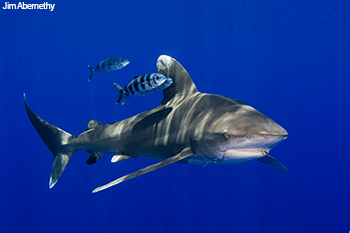 CITES meets every two to three years at the Conference of the Parties (CoP) to:
CITES meets every two to three years at the Conference of the Parties (CoP) to:
-
Discuss proposals to amend Appendix I or II by adding, transferring, or removing species.
-
Review implementation to understand progress on the species listed and discuss enforcement and compliance issues.
-
Determine a budget for the Convention.
-
Discuss any relevant reports on emerging threats or global trends that are causing the decline of species, such as a targeted poaching epidemic.
Each CITES Party sends a delegation to the CoP to discuss issues and vote on proposals and resolutions guiding the implementation of the treaty. Each Party has one vote, and a two-thirds majority of those voting is needed for a proposal to be adopted. Certain groups can attend the meeting to observe and participate in discussions, working groups, and committees but they do not have a vote. These, include:
-
Intergovernmental organizations, such as representatives from other international conventions and treaties that cooperate with CITES, for example, the Convention on Biological Diversity.
-
International and national nongovernmental organizations, including conservation organizations, universities, and trade representatives.
-
Representatives from countries that are not CITES Parties but wish to observe the proceedings.
So How Does CITES Work?
CITES Appendices: There are three CITES Appendices that provide varying degrees of protection for the species listed in the convention; enforcement is usually by national customs officials or police, and all Parties are required by the treaty to adopt legislation implementing CITES.
Appendix I: Species included in Appendix I are threatened with extinction, and international commercial trade in these species or their parts is prohibited. Trade for noncommercial purposes is allowed only in exceptional cases. For example, all seven species of marine turtles are listed on Appendix I in order to help reduce the severe impact that trade has had on their populations. About 600 animal species and 300 plant species are in Appendix I.
Appendix II: Species included on Appendix II are not yet threatened with extinction but could go in that direction if populations decline further and trade continues at an unsustainable rate. Appendix II still allows international trade, but it is regulated, which can give depleted species a chance to recover by ensuring through a rigorous permitting system that only sustainable and legal trade is allowed.
For example, only three sharks have global protections through CITES: great white, basking, and whale sharks. Countries agreed that these species would be listed on Appendix II because these shark populations were in decline. About 4,500 animal species and almost 30,000 plant species are included in CITES Appendix II.
Appendix III: This appendix includes species, listed by individual countries that regulate trade in them and need the assistance of the global community to prevent unsustainable or illegal exploitation, but do not involve determinations of sustainability. It requires that all countries exporting a species on Appendix III ensure that the species was obtained legally. About 270 animal species and 30 plant species are listed on Appendix III, including the walrus (listed by Canada) and red and pink corals (China).
2013: Will This Be the Year of the Shark?
The Pew Environment Group is advocating for the adoption of three shark proposals and one manta ray proposal, to include these species on Appendix II at CoP 16 (porbeagle, oceanic whitetip, and hammerhead sharks (scalloped, great, and smooth), and manta rays).
Fishing has drastically depleted shark and ray populations over the past 60 years. Of the shark and ray species assessed by scientists for the International Union for Conservation of Nature (IUCN), 30 per cent are threatened or near-threatened with extinction. Up to 73 million sharks are killed every year to support the international shark fin trade, with most of the fins ending up in shark fin soup.
Sharks and rays are slow to mature and have few offspring, making them extremely vulnerable to overfishing. Their life cycles are more similar to some mammals, such as lions and elephants, than to most fish, and it can take many years for populations to rebound once they are depleted. Overfishing by highly efficient modern fleets, illegal fishing, and bycatch (being caught in fishing gear but not as a legal/target species) is causing a drastic decline in shark populations wherever they are found, with international protection measures still patchy and piecemeal.
The successful conservation and management of sharks requires a wide range of measures, because sharks are highly migratory species that are caught both within national jurisdictions and on the high seas, and then traded in the international market.
Scalloped hammerhead sharks (Sphyrna lewini)
These sharks are found along the coastlines in warm, temperate waters of the Atlantic, Pacific, and Indian oceans. A proposal to include the species in Appendix II has been submitted by Brazil, Colombia, Costa Rica, Ecuador, the 27 member States of the European Union, Honduras, and Mexico along with the smooth and great hammerhead species because their fins look similar when traded.
-
Scalloped hammerheads are found along coastlines in warm, temperate waters of the Atlantic, Pacific, and Indian Oceans.
-
Scientists have estimated that 1.3 million to 2.7 million scalloped and smooth hammerheads are killed annually for the fin trade.
Learn more about the scalloped hammerhead shark.
Porbeagle shark (Lamna nasus)
A coastal shark (and smaller cousin of the great white shark) that ranges into international waters. It is found in cold-temperate waters worldwide. A proposal to include the species in Appendix II has been submitted by Brazil, Comoros, Croatia, Egypt and the 27 member States of the European Union.
-
Porbeagles, closely related to the great white shark, range along coasts and into international waters. They are found in cold-temperate waters of the north Atlantic and southern hemisphere.
-
Porbeagle meat is considered high quality, particularly in Europe, notably France, Spain and Italy. Porbeagle fins are also in demand for shark fin soup in Asia.
Learn more about the porbeagle shark.
Oceanic whitetip shark (Carcharhinus longimanus)
The oceanic whitetip is an open-ocean species with a distinctive white tip on its dorsal fin. A proposal to include the species in Appendix II has been submitted by Brazil, Colombia, and the United States.
- Although the oceanic whitetip is one of the most widespread shark species, found in tropical and temperate seas throughout the world, it is also one of the most threatened.
- Scientists have estimated that 250,000 to 1.3 million oceanic whitetip sharks are killed globally per year for the fin trade.
Learn more about the oceanic whitetip shark.
Manta ray (Genus Manta)
The oceanic manta ray (Manta birostris) is found around the world in tropical and subtropical waters; the reef manta (M. alfredi) is found in tropical and temperate waters. A proposal to include the genus in Appendix II has been submitted by Brazil, Colombia, and Ecuador.
- The oceanic manta ray (Manta birostris) is found around the world in tropical and temperate waters; the reef manta (M. alfredi) is found in tropical and subtropical waters of the Pacific, Atlantic and Indian Oceans.
- It is estimated that gill plates from more than 4,000 manta rays are traded annually for use in Asia in a purported health tonic.
